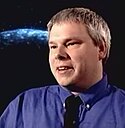Ian P. Griffin

Ian P. Griffin (* Januar 1966)[1] ist ein britischer Astronom und Asteroidenentdecker.
Er studierte Astronomie am University College London und erwarb dort 1991 den Doktorgrad.
Von 1990 bis 1995 war er Direktor des Armagh Planetariums in Nordirland. Von dort wechselte er an das Astronaut Memorial Planetarium and Observatory des Brevard Community College in Cocoa in Florida und danach an das Auckland Observatory in Neuseeland. Zwischen 2004 und 2007 arbeitete er als Direktor des Museum of Science and Industry in Manchester. Derzeit ist er Vorstand der gemeinnützigen Organisation Science Oxford[2].
Im Zeitraum von 1998 bis 1999 identifizierte er zusammen mit Kollegen insgesamt 25 Asteroiden[3].
Daneben entdeckte und beschrieb er das transneptunische Doppelsystem 1998 WW31 im Kuipergürtel.
Quelle
- Lutz D. Schmadel: Dictionary of Minor Planet Names. 5th ed. Springer, Berlin 2003, ISBN 3-540-00238-3 (engl.) [Voransicht bei Google Book Search]
| (10924) Mariagriffin | 29. Januar 1998 |
| (11678) Brevard | 25. Februar 1998 |
| (13376) Dunphy | 15. November 1998 |
| (14179) Skinner | 15. November 1998 |
| (17020) Hopemeraengus | 24. Februar 1999 |
| (23988) Maungakiekie | 2. September 1999 |
| (23990) Springsteen | 4. September 1999 |
| (25273) Barrycarole | 15. November 1998 |
| (27120) Isabelhawkins | 28. November 1998 |
| (31239) Michaeljames | 21. Februar 1998 |
| (31268) Welty | 16. März 1998 |
| (33179) Arsènewenger | 29. März 1998 |
| (49291) Thechills | 8. November 1998 |
| (85773) Gutbezahl | 25. Oktober 1998 |
Einzelnachweise
| Personendaten | |
|---|---|
| NAME | Griffin, Ian P. |
| KURZBESCHREIBUNG | britischer Astronom |
| GEBURTSDATUM | Januar 1966 |
Auf dieser Seite verwendete Medien
Screen capture of Dr Ian P Griffin, formerly head of public outreach at the Space Telescope Science Institute.
From a video at:
http://hubblesite.org/newscenter/newsdesk/archive/releases/2002/04/video/f
Copyright explicitly disclaimed at:
http://hubblesite.org/copyright/
"Copyright Notice
Material credited to STScI on this site was created, authored, and/or prepared for NASA under Contract NAS5-26555. Unless otherwise specifically stated, no claim to copyright is being asserted by STScI and it may be freely used as in the public domain in accordance with NASA's contract. However, it is requested that in any subsequent use of this work NASA and STScI be given appropriate acknowledgement. STScI further requests voluntary reporting of all use, derivative creation, and other alteration of this work. Such reporting should be sent to copyright@stsci.edu."